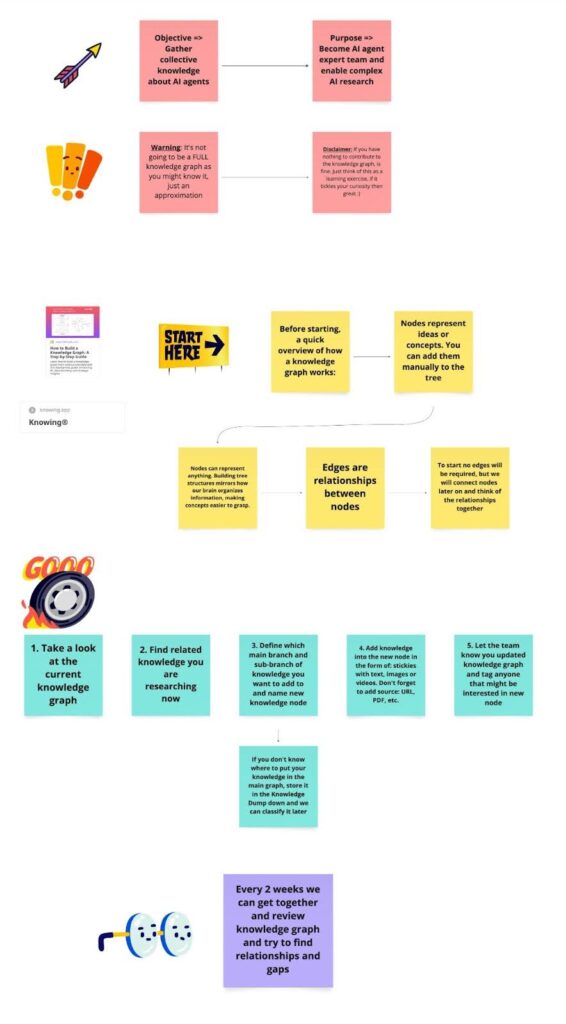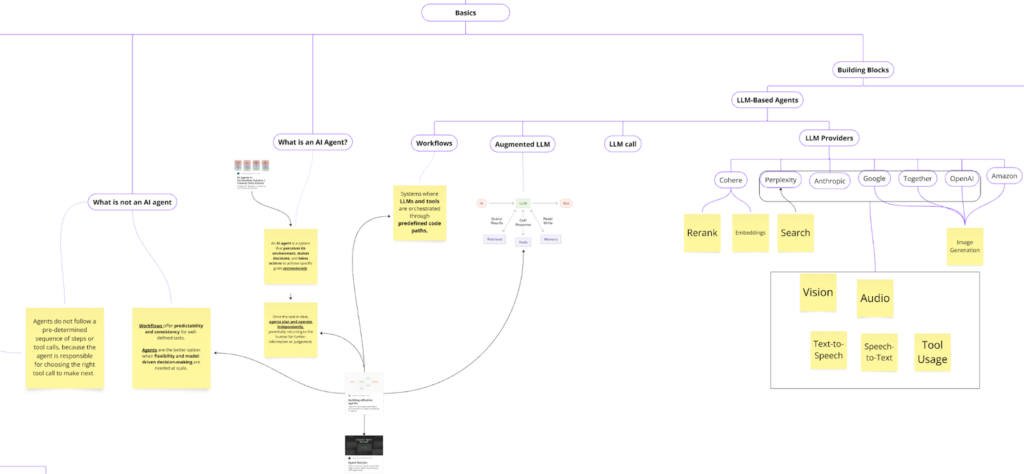Initial insights and knowledge sharing from our AI agents team
When we set out on our journey in the world of AI agents, we didn’t consider the amount of new knowledge and information in the form of articles, blog posts and a myriad of crash courses we would end up finding. To be honest, it was overwhelming and exciting at the same time as it was tough to define where to start and how to approach all these vast streams of information going around.
Let’s get something right from the get go: We have already worked with AI and have a full team dedicated to crafting and delivering AI products, however, it was our first step towards a new way of building them, in this case AI agent- based products. Acknowledging this made us realize that we needed to begin by aligning knowledge all around our team. This proved to be very challenging as the AI agent world is also a new field coming up from the artificial intelligence industry, therefore we had too many new concepts and perspectives to deal with in our heads.
To solve the problem of establishing this basic knowledge foundation, we needed to first determine how to construct this shared knowledge base. Then, we had to develop a collaborative process to create it, and finally, establish a method for continuously sharing this knowledge outside of the team. One thing to consider is that our team is composed of diverse roles and perspectives, including UX/UI designers, frontend and backend developers, machine learning engineers, and product managers, all of whom have a say in the knowledge base.
Knowledge graphs or how to build a visual knowledge base
A knowledge graph is a concept which we discussed and finally ended up choosing as the visual representation for all of the knowledge we were gathering from every role inside our team. As we now know a knowledge graph represents relationships between diverse and unstructured data points from different sources, this is a very useful and visual tool when you want to discover hidden connections between concepts or want to find patterns not visible to the naked eye.
Other benefits from a knowledge graph is that it offers contextual understanding and provides easy onboarding for new team members, also they could eventually become the main knowledge base for the company if developed properly. One thing we had to consider was that when we began building this knowledge graph we didn’t know about relationships yet, we only knew about interesting concepts we wanted to deep dive into inside AI agents’ high level topics, thus, a full and complete knowledge graph from scratch was not possible, it was a knowledge mind map, with some connections that were clear and some that we didn’t understand at the moment.
All knowledge not shared is knowledge lost
Initially, we went with a Miro board and an agile approach to keep improving things. However, figuring out how the team should interact, both offline and during online sessions, became a real pain point. This was intended to be a collaborative effort, not a solo project spearheaded by the PM. Hence, a quick and easy to follow step by step process was designed for anyone to use the Miro board, it consisted of a simple read-me guide with stickies explaining the main objective and purpose of the knowledge graph for the team, giving a quick overview of what a knowledge graph is and finally a process flow diagram showing how to interact with it (see image below).

Contributors to the knowledge graph were required to either tag a colleague who might be interested in the specific knowledge area or inform the entire team via our Slack channel that new content was available. To maintain transparency, all contributions had to include the content’s source. Comments or annotations were also encouraged to keep discussions live and ongoing throughout the team’s innovation sprints. Bear in mind this same team was also delivering an actual AI agent in the meantime, so discovering and exploring while developing a product was a huge undertaking, nevertheless it made a feedback loop and a continuous knowledge flow possible as well.
Moreover, a bi-weekly review meeting was scheduled just before the start of each new sprint. During the meeting, team members would share insights and learnings gained from the previous sprint, fostering a collaborative environment to identify knowledge gaps and potential areas for further exploration. The meeting concluded by determining new areas of knowledge to explore during the upcoming sprint for each team member. Just to share some initial insights on the first couple of sessions, it was possible to see that new ideas emerged based on the discussion organically, and also gaps were identified quickly with the visual aid of the graph (see a small snippet of the knowledge graph, it’s a mess I know).

Hi all, welcome to my AI agents talk!
To share our AI agents team’s growing knowledge base, we’ve initiated a periodic Knowledge Sharing Sessions (KSS) and written several stories behind experiments, tools and frameworks we have learned along the way. Stories have been part of our AI agents team from the start, as both articles and case studies have stemmed from our exploration and execution, sprint by sprint. Storytelling is a skill that we are constantly encouraging each member of our team to give it a go, and this has been a fun and bumpy ride so far. Don’t forget to check out this incredible article on this topic: Voice Agents Architecture.
KSS sessions on the other hand target a select group of colleagues who are most likely to benefit from the diverse range of AI agent topics. Consequently, it also empowered each team member to share their knowledge in an interactive way, preparing also to potentially present to customers or prospects that could be interested in AI agents.
Our initial approach is kind of similar to a Ted Talk, with the support in some cases of technical demos to showcase the value of new tools or frameworks that would also benefit other projects and areas inside the company. However, some of the KSS have been business oriented, with the aim of preparing the sales and marketing team to reach new target audiences and also to showcase our knowledge path and capabilities to the general public.
Wait, there’s more to come
Recently, we have already begun discussing how to go even further in the process of showcasing what we are working on, exploring and interested in diving deeper. Early talks have already set out and it looks like using that knowledge graph could be a really smart move. We might be able to create an innovation loop and get some buzz going with a fresh approach, in that case a Miro board would not suffice but we aim to create something interactive with prospects and anyone interested in AI agents.
You better stay tuned so you don’t miss out on it…AI agents homepage is coming soon to a theater near you!
